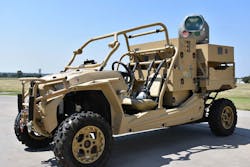Unmanned aerial vehicles (UAVs) have become commonplace as battlefield “birds of prey,” equipped for offensive maneuvers. Because they represent relatively low-cost weapons, suitable defensive measures should also be cost-effective, and the high-energy lasers (HELs) have proven to be quite capable in defending against armed UAVs. Raytheon Co. is working on bringing these defensive laser-based systems where needed, having developed low-cost dune buggies equipped with HELs that can combat rugged desert terrain (see photo).
“Basically, we’re putting a laser on a dune buggy to knock drones out of the sky,” explains Dr. Ben Allison, director of the company’s high energy laser product line, who works on Raytheon’s campus in McKinney, Tex. The job requires a bit more than simply bolting down a laser system into a ground vehicle, since the HEL must be combined with a variation of Raytheon’s Multi-spectral Targeting System infrared (IR) and electro-optical sensors, and with everything installed on a Polaris MRZR all-terrain vehicle—the aforementioned dune buggy.
Allison’s efforts were motivated by a report from Raytheon Chairman and CEO Tom Kennedy about an allied nation’s use of a Patriot missile to shoot down a low-cost drone equipped with grenade type munitions, as well as the need for a cheaper means to shoot down armed drones. Allison sought to use Raytheon’s existing resources to develop a more cost-effective counter-UAV defense system than a Patriot missile, and without having to perform an extended amount of research to achieve the solution. By combining the HELs with the multiple sensors on an all-terrain vehicle, the defensive system provides the necessary power and the mobility needed to defense against UAVs. It can run on stored charge from 220 VAC or be equipped to run on a generator on board the all-terrain vehicle.
About the Author
Jack Browne
Technical Contributor
Jack Browne, Technical Contributor, has worked in technical publishing for over 30 years. He managed the content and production of three technical journals while at the American Institute of Physics, including Medical Physics and the Journal of Vacuum Science & Technology. He has been a Publisher and Editor for Penton Media, started the firm’s Wireless Symposium & Exhibition trade show in 1993, and currently serves as Technical Contributor for that company's Microwaves & RF magazine. Browne, who holds a BS in Mathematics from City College of New York and BA degrees in English and Philosophy from Fordham University, is a member of the IEEE.

